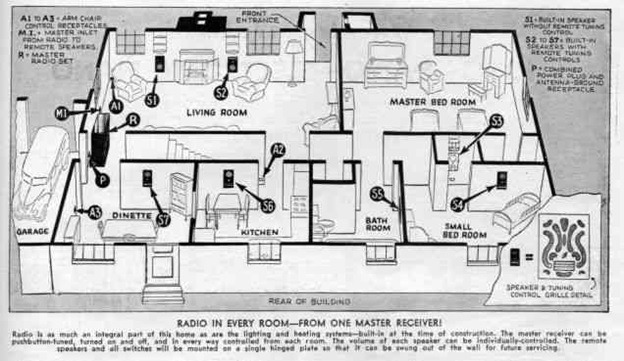We’ve heard about these future pipe dreams our entire lives – innovations that would change out lives, like flying cars, robots that do the housework, vacations on the moon, and a radio in every room.
Wait – a radio in every room?
It turns out that Radio-Craft magazine published a series way back in 1939 that talked about a dream home in Teaneck, New Jersey, that would feature radio in every room. Working with companies like RCA, Radio-Craft had these visions that the American Dream of home ownership would fall short if there wasn’t radio access in every single room of the house. At the time, of course, radio was the hot medium and the thought of it piped through the house was probably just as cool as Sonos or Apple TV.
In the blog Pale of Future, writer Matt Novak chronicles this failed project. And while there may have been all sorts of construction snafus and other setbacks, it turns out that the main roadblock had more to do with a problem many of us can relate to today: the family couldn’t agree on a single entertainment option.
According to the June issue of Radio-Craft, the dream of radio in every room in the house controlled by a single receiver was doomed before it got off the ground. As Novak puts it, that’s because Dad may have wanted to hear news of the war in Europe, while Mom desired her radio dramas, and those crazy kids just wanted to jam to Big Band music.
All of this comes at an interesting intersection in the history of the consumer electronics industry. Amazingly at CES, more and more display space is being devoted to the so-called “smart home” – technology that manages and controls more and more of the everyday conveniences in our dwellings. As you walk the vast convention halls in Las Vegas each January, you see more household appliances that have been electronically souped up and connected through the home’s WiFi network.
The New York Times recently wrote bout Quirky, a start-up that focused on new product concepts, many of which fall into this category. And its new spin-off, Wink, is essentially software that connects home devices via smartphone and tablet apps. These hardware hubs enable many devices to function within the same system, controlling everything from lights to thermostats to video cams to other household devices.
Yes, even radios.
Had there been these systems back in the ‘30s, you can bet that radio would have been near the top of many lists of most desired household connections. Today, radio might have a hard time competing with the microwave or the exterior lights. A radio in every room is child’s play today, given our rapidly advancing technology. Now it’s more a matter of whether consumers truly desire broadcast radio in multiple rooms where they live – especially young people.
We saw the very beginnings of radio’s “in home problem” in “The Bedroom Project” back in 2007 where we videotaped “home invasions” among mostly twentysomethings in Columbus, Ohio, and L.A. commissioned by Arbitron – radio’s first ethnographic study.
While our respondents were very much engaged with cell phones, Facebook, and video games, many did not have a working radio in their dorms and apartments. It wasn’t until we made the trek to their garages and parking lots where radio showed up in their dashboards.
Who can forget Eric, a 23-year-old grad student in L.A. who rigged a shower radio over his rear-view mirror to enjoy listening to the radio while he drove? (He’s probably the CEO of a tech start-up today.)
Technology is a wonderful thing, making accessibility and convenience possible for millions. But it is essential and compelling content that truly drives consumers’ tastes and desires.
It was that way in 1939 and it’s the same way today.
- What To Do If Your Radio Station Goes Through A Midlife Crisis - April 25, 2025
- A 2020 Lesson?It Could All Be Gone In A Flash - April 24, 2025
- How AI Can Give Radio Personalities More…PERSONALITY - April 23, 2025






Wow….I must be a reincarnated soul from the ’30s. I DO have a radio in every room of my house!
Somehow I’m not surprised. Thanks, Biv.
from growing up and living in places where hurricanes and tornadoes are facts of life, my first thought was — how could you not have radios? battery powered ones, though.
And of course, radio always shines in emergencies. Thanks, Kerry.
Today people have a radio not only in every room but in every location they are via their mobile device. Problem is, w/some of America’s most important companies now in the radio biz (Apple, Google, Microsoft) + mega-competition from Pandora, Spotify, etc. – hundreds of thousands of choices exist (w/lower spotlods) along side broadcast radio’s very sparse online content menu. If broadcast radio’s core competency is content, our tiny investment in funding that competency only provides momentum to the audience surge from FM to mobile. Broadcast radio needs a “Manhattan Project” for online content – big, BOLD, original content/stations. Is one reason why Borrell forecasts a 42 minute TSL collapse over next 4 years for broadcast radio because they don’t believe broadcasters will invest in the platform where 12-30 year olds are migrating in mass? https://drive.google.com/file/d/0B_pxKkiQlibyd0RrWUFxX0tPZXc/edit?usp=sharing
Paul, the puck is moving…and fast. Thanks for the wake-up comment and for reading our blog.